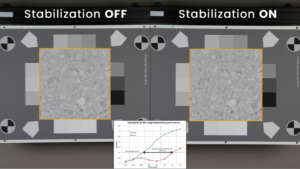
How Can We Measure Image Stabilization? (2/2)

Image stabilization is key to capturing sharp photos and smooth videos, especially in low light or handheld conditions. Modern devices rely on several stabilization technologies:
- Optical Image Stabilization (OIS): Compensates for small angular movements by physically shifting lens elements,
- In-Body Image Stabilization (IBIS): Adjusts the image sensor itself to counteract camera shake,
- Electronic Image Stabilization (EIS): Uses software-based motion analysis and frame cropping to digitally stabilize the image.
Each system has its strengths and limitations, and its performance can vary greatly depending on the situation. While the CIPA DC-X011 standard defines how photo stabilization should be evaluated for digital cameras, DXOMARK has developed advanced tools for both photos and videos, extending these principles to more realistic and repeatable testing conditions for any camera system.
Photo Evaluation: Improving on the CIPA Standard
For photo stabilization testing, the protocol basically reproduces the CIPA standard. The camera is mounted on a shaking platform. Then it captures hundreds of images with and without enabling the stabilization solution under test. The captured images are analyzed by measuring the sharpness of the texture part of the Deadleaves chart and the apparent motion on the markers. The measurements used differ from CIPA’s, enabling a more realistic evaluation and aligning with modern IQ standards. The objective is to determine the longest exposure time that keeps blur below a defined threshold, corresponding to acceptable sharpness.

Video Evaluation
Video stabilization testing follows a similar principle but focuses on frame-to-frame motion. Using Deadleaves/Texture patterns under controlled lighting, DXOMARK analyzes the apparent motion across successive frames with sub-pixel precision. From this, DXOMARK quantifies translation, rotation, zoom, keystone distortion, and rolling-shutter effects, providing a complete evaluation of stabilization efficiency. This approach evaluates not only how well a system keeps the scene stable, but also how it manages image distortions caused by rolling shutter in CMOS sensors. DXOMARK’s video stabilization measurements assess how effectively the device’s stabilization system minimizes both visible motion and unwanted geometric distortion.
Robotic Motion Platforms for Repeatable Testing
Repeatable evaluation
At the heart of DXOMARK’s testing environment are hexapod motion platforms, including the H840 and H860 systems. These platforms generate motion profiles to simulate real user scenarios, such as:
- Holding an action camera still (handheld motion)
- Recording video while walking or running (walking & running motion)
- Filming while riding a bike (biking motion)
The six-axis robotic devices reproduce complex hand and body movements with high accuracy and repeatability. This approach ensures that every test follows the same precise motion pattern, allowing for objective and repeatable comparisons between different stabilization systems.
By combining motion-controlled platforms, realistic motion profiles, precise lighting, and advanced analysis software, DXOMARK’s stabilization testing delivers results that are both scientifically rigorous, repeatable, and representative of real-world camera behavior.

 DSLR & Mirrorless
DSLR & Mirrorless  3D Camera
3D Camera  Drone & Action camera
Drone & Action camera 
